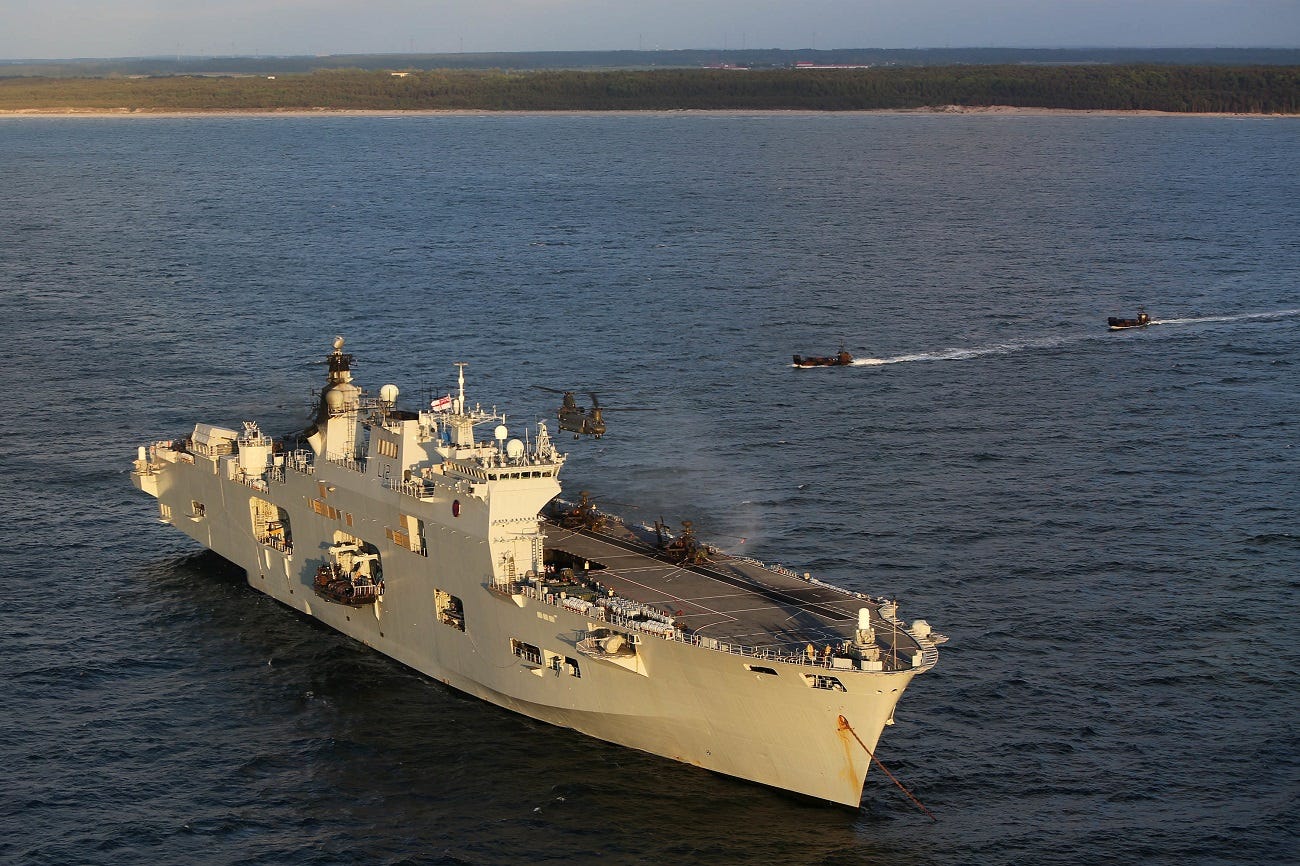by ROBERT BECKHUSEN
The helicopter carrier HMS ‘Ocean’ will sail into the sunset unless Britain finds the money … and the sailors
HMS Ocean, the British Royal Navy’s flagship, will retire in 2018 to be either sold or scrapped.
She is Britain’s sole carrier, at least until the 280-meter-long HMS Queen Elizabeth becomes fully operational in 2020. A second new flattop, Prince of Wales, will be ready for combat in 2023. These ships will initially operate 24 vertical-lift F-35B Joint Strike Fighters each.
The 203-meter-long Ocean, however, is not a “true” carrier. She is an amphibious assault ship with 18 helicopters and no fighter jets — and her cavernous hold allows the vessel to disgorge hundreds of Royal Marines aboard landing craft.
Which means that for five years, the Royal Navy’s amphibious capability will fall to its two smaller Albion-class landing docks, of which only one is currently operational due to cost. During that time, the Royal Navy will modify Prince of Wales to take over Ocean’s job, with Queen Elizabeth to possibly follow.
There is deep uneasiness about this in British military circles. Not the least because it’s exceedingly unlikely both Queen Elizabeth-class carriers will operate at the same time. Carriers are complex machines and need regular maintenance, so one will likely rest in dock when the other is away.
More to the point, the Royal Navy will have to make choices when Prince of Wales is at sea. The flattop could focus on training with her amphibious modifications, or behave as a true carrier … albeit one that just happens to launch Marines from time to time.
The problem with doing several things is that you’re a master of none.
 HMS ‘Ocean’ with helicopters and landing craft off the Polish coast in June 2015. U.S. Navy photo
HMS ‘Ocean’ with helicopters and landing craft off the Polish coast in June 2015. U.S. Navy photo
Different missions require different vessels, and in some situations, a smaller carrier is preferable to a bigger one.
The 21,500-ton Ocean is partially built to civilian manufacturing standards, which makes her relatively cheap to operate, but more vulnerable in a war.Ocean-based Apache gunships participated in the 2011 NATO war in Libya, but forces loyal to dictator Muammar Gaddafi couldn’t strike back.
It would be an enormous understatement to say the situation would be different versus Russia — or other foes around the world.
As Ocean is a helicopter carrier, she would need protection from Queen Elizabeth-class flattops and their F-35s. Her helicopters would come in handy for hunting hostile submarines, although Ocean was not initially designed with this role in mind.
However, Ocean trained to hunt submarines with her Merlin, Sea King and Lynx helicopters as recently as summer 2016. Ocean’s civilian standards also make her better suited for humanitarian and disaster relief missions compared to a fully-fledged, $5.5 billion battle carrier.
To be sure, big carriers can — and do — respond to disasters, but it’s good to have options.
The online campaign Save the Royal Navy has urged the British government to reconsider retiring Ocean, but it’s a tall order. For instance, the Royal Navy simply doesn’t have enough sailors to crew her and its twin Queen Elizabeths.
Once Prince of Wales arrives, Ocean will have to go. Or at the least, she won’t sail. But the campaign — comprised of civilians, academics and former Royal Navy sailors — has suggested putting the ship in reserve.
“This would give the option of activating the ship in an emergency (using naval reservists and moving manpower from non-essential jobs),” the campaign’s website noted.
“If the manpower situation was to ease HMS Ocean could possibly be reactivated in future.”
But another problem, which the campaigners quickly point out, is the fact that Ocean is aging.
The carrier launched in 1995 with an expected service life of 20 years, and she requires retrofitting to stay seaworthy.Ocean completed her last upgrade in 2015, and the flattop is not too old in absolute terms, but every penny counts for Britain’s tight defense budget.
“To re-activate her might require some work but better to have a ship in an imperfect state than no ship at all,” the campaigners asserted. “Who would bet against her giving good service for at least another decade if sold to a lower-tier foreign navy?”
It’d be a risky bet.
No comments:
Post a Comment